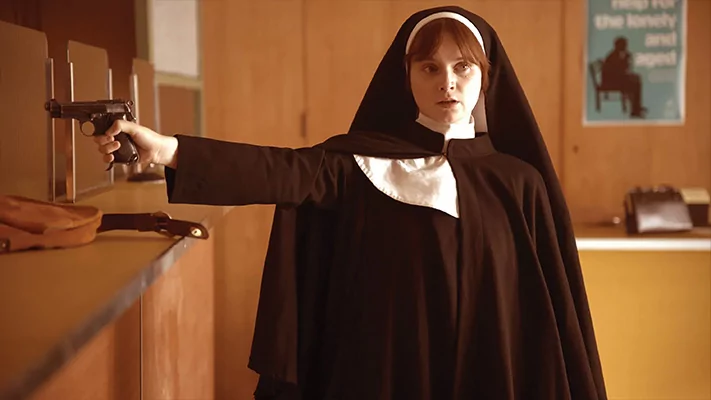
In 2018 the journalist Patrick Radden Keefe, a writer at the New Yorker who is particularly adept at using true crime as a vehicle for probing intellectual questions, published Say Nothing: A True Story of Murder and Memory in Northern Ireland. The book looked at the ripple effects of a notorious, decades-old crime: the 1972 abduction and “disappearance” of Jean McConville, a widowed mother of 10 who local IRA guerrillas believed, perhaps wrongly, to be a British informant at the height of the “Troubles” in Northern Ireland.
This was a 560-page nonfiction book about a faraway conflict that few Americans had thought about in a long time. Although not without critics, it was also grippingly written, rigorously reported, and even uncovered the possible identity of the person who pulled the trigger of the gun that killed the tragic McConville. The book became a sensation and a surprise bestseller. Now Hulu, Disney+, and FX have co-produced a dramatic nine-part miniseries adaptation, created by Josh Zetumer and with the involvement of Keefe. I’m happy to say that it mostly does Keefe’s book justice.

Like the book, the miniseries is broad in its sweep and often flashes back and forth in time. One timeline takes place in the 2000s, when an obscure academic project at Boston College accidentally unearths stories from the Troubles that many people would prefer left forgotten. A historian is interviewing former republican (pro-Irish) and loyalist (pro-British) paramilitaries; these gunmen, some of whom committed unspeakable acts of violence, agree to talk on the condition that the oral history tapes remain sealed in a vault in Boston until their deaths.
The paramilitaries include Dolours Price (played in her older version by Maxine Peake), once a firebrand female IRA volunteer. When the Northern Irish police learn of the tapes, they want to seize them as evidence for an investigation into unsolved disappearances, considered war crimes, perpetrated during the Troubles.
An earlier timeline follows the younger Dolours (Lola Petticrew) and her sister, Marion Price (Hazel Doupe), two siblings in a lower-middle-class Catholic family in Belfast in the late 1960s and early ’70s. Like other Catholics in Northern Ireland, Dolours and Marion are effectively second-class citizens in a British exclave where Protestants control the overwhelming share of political and economic power. The Price sisters come from a longtime republican family; their parents are both proud former IRA volunteers, and their aunt Bridie, who lives with the family, lost her eyes and hands when a bomb she was assembling exploded years earlier.
The young sisters, however, are idealists who reject their parents’ cynicism. They believe that nonviolent rallies inspired by the American civil rights movement can help secure more rights for Catholics and bring about the eventual reunification of Ireland. That idealism is shattered when the sisters join a peaceful protest march that then gets viciously attacked by local Protestants as police look on and do little.
Dolours, followed by the more reticent Marion, decides to join the local guerrilla unit of the Provisional IRA, led by the charismatic Brendan Hughes (Anthony Boyle). During a riot Dolours and Marion also meet a geeky but capable young man, Gerry Adams (Josh Finan), who seems to be a rising intellectual mastermind of the IRA strategy in Belfast. (As a disclaimer in the show’s credits notes, Adams, later a parliamentarian, has always denied being a member of the IRA, though Northern Irish people of all stripes tend to regard this with raised eyebrows.) The Price sisters are frustrated when the IRA men refer them to a women’s branch, Cumann na mBan, and treat them as helpmates. They decide to prove their worth by robbing banks for IRA funds.
The sisters thrive in their new lives as guerrillas, which Say Nothing depicts in a series of tense, exhilarating, and sometimes darkly funny sequences. This is obviously a risky strategy for a nonfiction television adaptation: Someone catching only parts of the first half of the show might be left with a genuine impression that the series glorifies violence or indulges in IRA hagiography.
The second half of the series works hard to nuance and complicate that portrayal, and also makes clear that the show is pursuing the kind of approach taken by, say, the 2008 German film Baader Meinhof Complex — intoxicate with the seductive allure of political violence, build to a thrilling drug-like high, then come crashing down.
The crash takes many forms, including prison terms for the Price sisters for their roles in a series of London bombings. One of the show’s single most haunting sequences, and one of the more poignant I’ve seen in any recent TV series, sees Dolours enlisted to help bring a friend of hers to an IRA court-martial where he faces certain death. Then there is the matter of McConville (Judith Roddy), whose grown children, absent even their mother’s body, have spent decades unable to truly grieve.
CLICK HERE TO READ MORE FROM THE WASHINGTON EXAMINER
Some critics and journalists have argued that Say Nothing falls short in conveying the full costs of the Price sisters’ actions, particularly regarding the victims of their London bombings. And that may be true. One of McConville’s sons has also criticized the decision to make the show at all. Either way, the show is hardly propaganda. It is nuanced, gritty, and well worth watching.
J. Oliver Conroy’s writing has been published in the Guardian, New York magazine, the Spectator, the New Criterion, and other publications.







